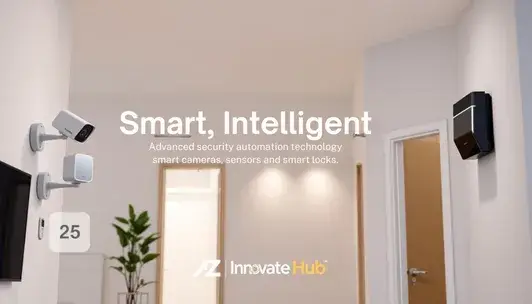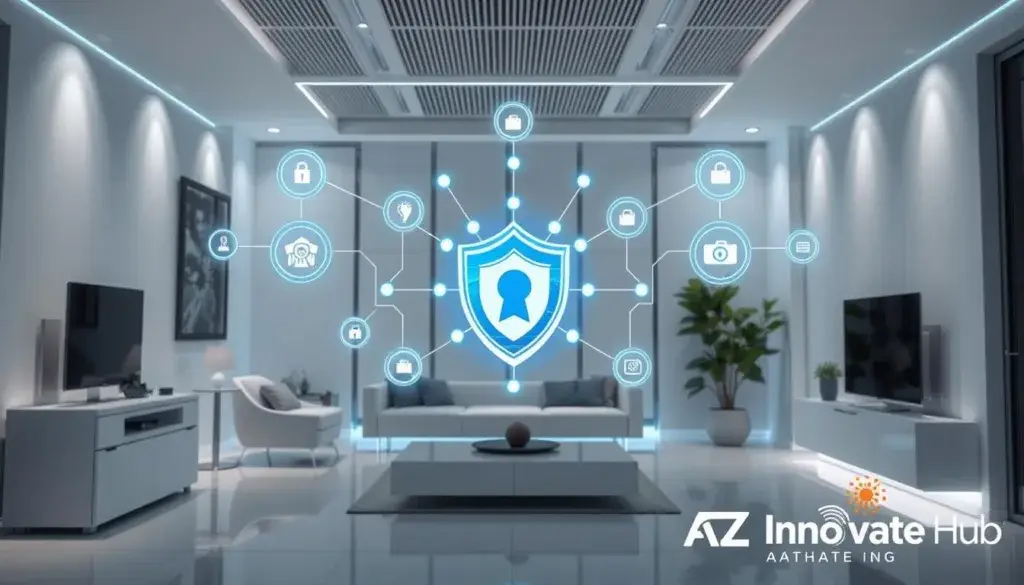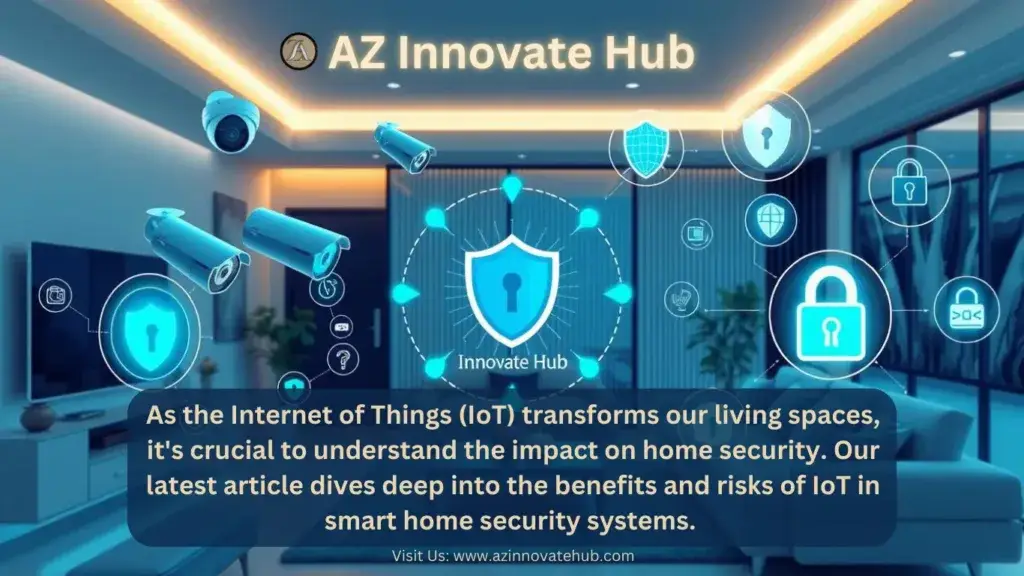
Did you know Security experts agree that burglars steer clear of homes with clear security signs? Smart home security automation is changing the game, making homes safer and more convenient. This tech combines various parts, offering round-the-clock monitoring, mobile access, and smart integration for easy use. As the demand for smart home security grows, with market expected to hit over $135 billion by 2024, automated systems are becoming key for home safety.
This article will cover the basics of smart home security automation. It’s designed to help even newbies understand how to keep their devices safe and private. You’ll learn how to enjoy the perks of modern technology while keeping your home secure.

Key Takeaways
- Smart home security automation integrates multiple technologies for enhanced safety.
- Automated security systems are essential for effective home protection and peace of mind.
- Features like real-time monitoring and mobile access ensure constant surveillance.
- Security systems can be tailored to meet individual needs through customization
- The rise of smart technology in homes adds convenience and efficiency.
- Investing in advanced security systems helps deter potential threats.
- Smart integrations with other devices create a cohesive home automation ecosystem.
Introduction to Smart Home Security Automation
Smart home security automation combines technology with convenience. It lets homeowners manage and monitor their homes from anywhere. This is crucial for safety, as it provides real-time alerts and control over devices.
By 2025, the global smart home market is estimated to reach $185.83 billion, surpassing initial projections of $141 billion. Driven by a 25.30% CAGR from 2024 to 2029, the market will expand from $120.10 billion in 2024 to $370.95 billion by 2029.
Brief overview of smart home security automation and its importance
The evolution of smart home security systems has revolutionized the way we protect our homes and families. A pivotal moment in this transformation was the introduction of Wi-Fi technology in the late 1990s, which enabled seamless communication between devices without the constraints of wires. This breakthrough paved the way for the development of sophisticated, interconnected security systems that have become indispensable in today’s digital age.
As concerns about personal data security continue to escalate, the importance of robust smart home security systems cannot be overstated. With the capacity to integrate various components, such as door and window sensors, monitor detectors, and video cameras, these systems provide comprehensive protection and unparallelled peace of mind.
Moreover, the ability to monitor and control these systems remotely through mobile apps has redefined the concept of home security, empowering homeowners to stay vigilant and respond promptly to potential threats, regardless of their physical location.
Benefits of automated security for modern homes.
Automated security systems offer a multitude of benefits that extend far beyond mere safety. They also simplify and streamline daily life, making it more convenient and efficient. One of the most significant advantages of these systems is their ability to adapt to our lifestyle habits. Smart devices can learn our daily routines, adjusting lighting, temperature and energy usage accordingly. This not only enhances comfort but also leads to substantial energy savings, reducing our carbon footprint and lowering utility bills.
Furthermore, the seamless integration of various smart devices is a key focus area for companies in this sector. Efforts are underway to ensure that devices from different manufacturers work together harmoniously, creating a cohesive and user-friendly experience. This interoperability enables homeowners to control and monitor their security, lighting, thermostat, and entertainment systems from a single interface, eliminating the need for multiple apps and controls. As technology continues to evolve, the potential for automated security systems to transform our living spaces into intuitive, responsive, and sustainable environments will only continue to grow.
Growing need for smart home security in today's world
With home burglaries on the rise, homeowners are increasingly seeking robust security solutions to safeguard their families and possessions. Simultaneously, there is a burgeoning interest in smart homes that not only ensure safety but also optimize energy efficiency. Homeowners aspire to create a secure and sustainable living environment, leveraging advanced technologies to minimize energy consumption while maximizing protection.
However, as smart devices become increasingly interconnected, the risk of cyber breaches and unauthorized access grows, underscoring the imperative for robust security measures that prioritize both physical and digital protection.
Key Components of Home Security Automation Systems
Home security systems comprise multiple vital components that harmonize to create a secure and convenient living environment. These interconnected elements, including door and window sensors, motion detectors, video cameras, and smart locks, work in tandem to safeguard homes against potential intruders. By seamlessly integrating these features, homeowners enjoy enhanced peace of mind, knowing their family and property are protected around the clock.
Motion Detectors & Door/Window Sensors
Motion detectors play a pivotal role in modern security systems, utilizing advanced infrared and passive infrared (PIR) technologies to detect even slight movements within designated zones. Upon detection, these devices instantly alert homeowners via smartphone notifications or dedicated security apps, ensuring prompt awareness of potential breaches. Complementing these detectors are door and window sensors, which employ magnetic contacts and reed switches to prevent unauthorized entry. These sensors seamlessly integrate with smart home systems, sending real-time alerts to homeowners’ phones or tablets, thereby ensuring constant vigilance and swift response to suspicious activity.
Smart Locks and Access Control
Smart locks serve as the primary bulwark against unauthorized entry, safeguarding home’s vulnerable entry points with cutting-edge technology. Leveraging advanced wireless communication protocols, such as Bluetooth and Wi-Fi, these locks enable seamless remote locking and unlocking via smartphones or voice assistants. This convenient keyless access allows homeowners to grant entry to guests, service providers, or family members without compromising security or physical key distribution. By integrating with smart home systems, smart locks also provide real-time access monitoring and alerts, ensuring enhanced security and peace of mind.
Alarm System and Notifications
Advanced alarm systems serve as a crucial first line of defense, swiftly alerting homeowners to potential break-ins via real-time notifications, whether they’re on-site or away. Leveraging advanced technologies like GSM, LTE, and IP connectivity, these systems ensure seamless communication with emergency services. Upon detection, a robust alarm system triggers a loud siren and automatically dispatches authorities, utilizing sophisticated algorithms to minimize false alarms and ensure prompt police response, there safeguarding homes and families.
Smart Lighting as a Security Feature
Smart lighting plays a pivotal role in home security, leveraging advanced scheduling and automation capabilities to deter potential intruders. By programming lights to simulate occupancy through customizable on/off cycles, homeowners can create the illusion of presence, even when away. Utilizing wireless communication protocols like Zigbee and Z-Wave, smart lighting systems can be controlled remotely via smartphones or voice assistants, ensuring seamless management from anywhere. This fusion of convenience and security effectively deters unwanted visitors, providing an additional layer of protection and peace of mind.
Security Cameras: Indoor/outdoor, wireless options
Security cameras are essential for watching over homes. They can be set up indoors and outdoors without wires. You can see what’s happening at home from anywhere with mobile apps. This technology has made homes safer for over 10 million people.

Popular Smart Home Security Platforms
Choosing the right smart home security platforms is key as technology advances. Homeowners can pick from brands like Google Home, Amazon Alexa, and Vivint. Each offers special features for a safe modern home. These platforms make security systems work better together.
Overview of top platforms like Google Home, Amazon Alexa, Vivint, etc
Google Home and Amazon Alexa have established themselves as pioneers in smart home security, revolutionizing device control with intuitive voice commands and seamless integration capabilities. Leveraging advanced natural language processing (NLP) and machine learning algorithms, these platforms effortlessly manage a vast array of devices. Meanwhile, Vivint stands out for its cutting-edge technology and comprehensive monitoring services, boasting features like 24/7 video surveillance, biometric authentication, and AI-driven threat detection. With Vivint’s smart hub and mobile app, homeowners enjoy unparalleled control and peace of mind, solidifying its position as a top choice in the smart home security market.
Compatibility and integration features for seamless automation
Most security devices work with Alexa and Google Home hubs, giving you options. Alexa lets you control devices with voice commands. Google Home lets you manage many devices at once. This makes your home automation smooth and easy.
Factors to consider when choosing a security platform
When picking a security platform, think about device compatibility, ease of use and support. Start systems cost between $150 to $300, while bigger systems are pricier. Monthly fees vary with professional services costing more than DIY options. ADT offers affordable starter packages with professional monitoring.

DIY vs. Professional Smart Home Security Installation
When considering home security solutions, homeowners face a critical decision: DIY installation or professional expertise. This choice hinges on several key factors, including upfront costs, system complexity, and technical expertise. DIY security systems offer a cost-effective approach, saving homeowners up to 50% on installation fees. However, they often require technical savvy and time-consuming configuration. On the other hand, professional installation provides seamless integration, advanced features, and ongoing support, but at a higher upfront cost. By weighing the pros and cons, homeowners can make an informed decision, balancing financial savings with the value of expert knowledge and peace of mind.
Pros and cons of DIY vs. professionally installed systems.
While DIY systems offer affordability and ease of setup, they may require technical expertise and have limited support. Professional installations ensure correct setup, thorough testing, and ongoing assistance, but at a higher cost. Homeowners must weigh the benefits of convenience and expertise against the added expense.
Step-by-step guide for a DIY setup
Step 1: Unboxing and Inventory (10-15 minutes Approx.)
Carefully unbox your security system components, including:
- Hub/control panel
- Sensors (door/window, motion)
- Cameras (indoor/outdoor)
- Power adapters
- Mounting hardware
Verify all components are included and undamaged.
Step 2: Hub Placement and Powering (15-30 minutes Approx.)
- Choose a central location for the hub (e.g., living room, hallway)
- Ensure proximity to a power outlet.
- Connect the power adapter and turn on the hub.
Step 3: Sensor Placement and Connection (30-60 minutes Approx.)
- Identify strategic locations for sensors (e.g., doors, windows, corners).
- Follow manufacturer instructions for mounting sensors.
- Connect sensors to the hub using wireless or wired connections.
Step 4: Camera Installation and Alignment (30-60 minutes)
- Select optimal camera locations (e.g., entrances, hallways).
- Mount cameras using provided hardware.
- Adjust camera angles and focus for clear views.
Step 5: System Configuration and Testing (30-60 minutes Approx.)
- Download and install the security system app.
- Follow in-app instructions for system configuration.
- Test sensors, cameras, and alerts to ensure proper function.
Step 6: Final Check and Maintenance (10-15 minutes)
- Double-check all connections and placements.
- Test system notifications and alerts.
- Schedule regular system checks and software updates.
Additional Tips:
- Refer to manufacturer documentation for specific setup requirements.
- Consider consulting online tutorials or customer support.
- Ensure battery-powered devices have fresh batteries.
Consideration for those opting for professional services.
Choosing professional installation has its own benefits. Experts can help avoid setup mistakes. But you’ll need to pay an installation fee, starting at about $100. You might also face monthly monitoring costs, from $45 to $60.
Many find the quality support from pros worth it. It’s a popular choice for many homeowners.

How to Secure Smart Home Devices Against Cyber Threats
Smart home technology is becoming a big part of our lives. But it also brings cybersecurity risks. Smart devices are at risk because they connect to the internet and often lack strong security. Weak passwords and poor user authentication are big problems.
With more people using smart speakers, video doorbells, and thermostats, it’s key to know how to protect them.
Common security risks in smart home automation
Smart home automation faces several security risks, including:
- Weak password policies that allow attackers to gain easy access.
- Inadequate encryption during data transmission, exposing sensitive information.
- Inadequate security measures leading to increased susceptibility to cyber threats.
- Potential hacking due to insufficient built-in security features.
Tips on securing smart devices (passwords, firewalls, software updates)
To reduce security risks, homeowners should:
- Use strong, unique passwords for each device and update them regularly.
- Enable multifactor authentication for an added layer of security.
- Implement firewalls to protect the home network.
- Maintain regular software updates for all devices to address security flaws
Best practices for securing wireless networks.
Securing wireless networks is crucial for protecting smart home devices. Best practices include:
By following these practices, homeowners can improve their home’s cybersecurity. This will help lower the risk of cyber-attacks.
Real-World Examples of Effective Smart Home Security
Smart home setups have changed how we keep our homes safe. They show how technology can make our homes more secure. Many case studies show how different systems work together to keep us safe and make life easier.
Case studies or scenarios highlighting effective setups.
A family used a smart security system with locks, video doorbells, and motion detectors. This setup lets them watch their home from anywhere. They get alerts on their phones, making them feel safer.
Comparison of different types of automated security systems in action.
Looking at security systems, ADT and Vivint are often compared. ADT has a high SecureScore of 9.2/10 and offers many smart products. Vivint also has a high SecureScore™ of 9.1/10, showing its strong security tech.
SimpliSafe is known for being affordable and easy to use. People pick systems based on what they need, like cost or advanced features. The right system can make a big difference in keeping homes safe.

Future Trends in Home Security Automation
The world of home security is changing fast. New technologies are making homes safer. Homeowners want the best protection, and new trends are meeting that need.
AI and machine learning in predictive security
Artificial Intelligence is changing home security. It uses machine learning to spot threats before they happen. These systems learn from how we act and what’s unusual, making homes safer.
In 2024, AI and machine learning will be big in-home security. They will make the industry better.
Integration of IoT with home security for smarter insights
IoT is key for better security. It lets devices talk to each other for better control. Now, you can check your security from anywhere with your phone or tablet.
IoT also helps find dangers like smoke or water leaks. This makes homes even safer.
Emerging tech, like biometrics and 5G’s role in security automation
New tech like biometrics adds safety. It uses facial and fingerprint scans for security. 5G makes monitoring faster and more reliable.
More homes are getting smart devices. People want smart light bulbs and plugs. This shows a growing interest in smart security.
Conclusion and Best Practices
Smart home security automation makes homes safer and more convenient. With smart homes set to grow to 478.2 million by next year, it’s key to have good security. Homeowners should know about their security systems, fight cyber threats, and choose the right setup for them.
Keeping devices updated is vital, as 80% of IoT devices face many attacks. Making sure devices work well together also helps. Getting a good monitoring system is a smart move for safety.
Following smart home security tips helps protect your home and makes life easier. Even though tech companies must keep devices safe, homeowners need to stay alert too. Keeping up with digital dangers is the best way to stay safe.

FAQ
Disclosure
- Some links on this website may be affiliate links, which means we may earn a commission if you click or make a purchase through them.
- We only recommend products we believe in and use ourselves.
- Our affiliate relationships do not influence our content or opinions.
- Prices and availability may vary.




Pingback: Affordable Home Security Camera: Top Picks for Every Budget